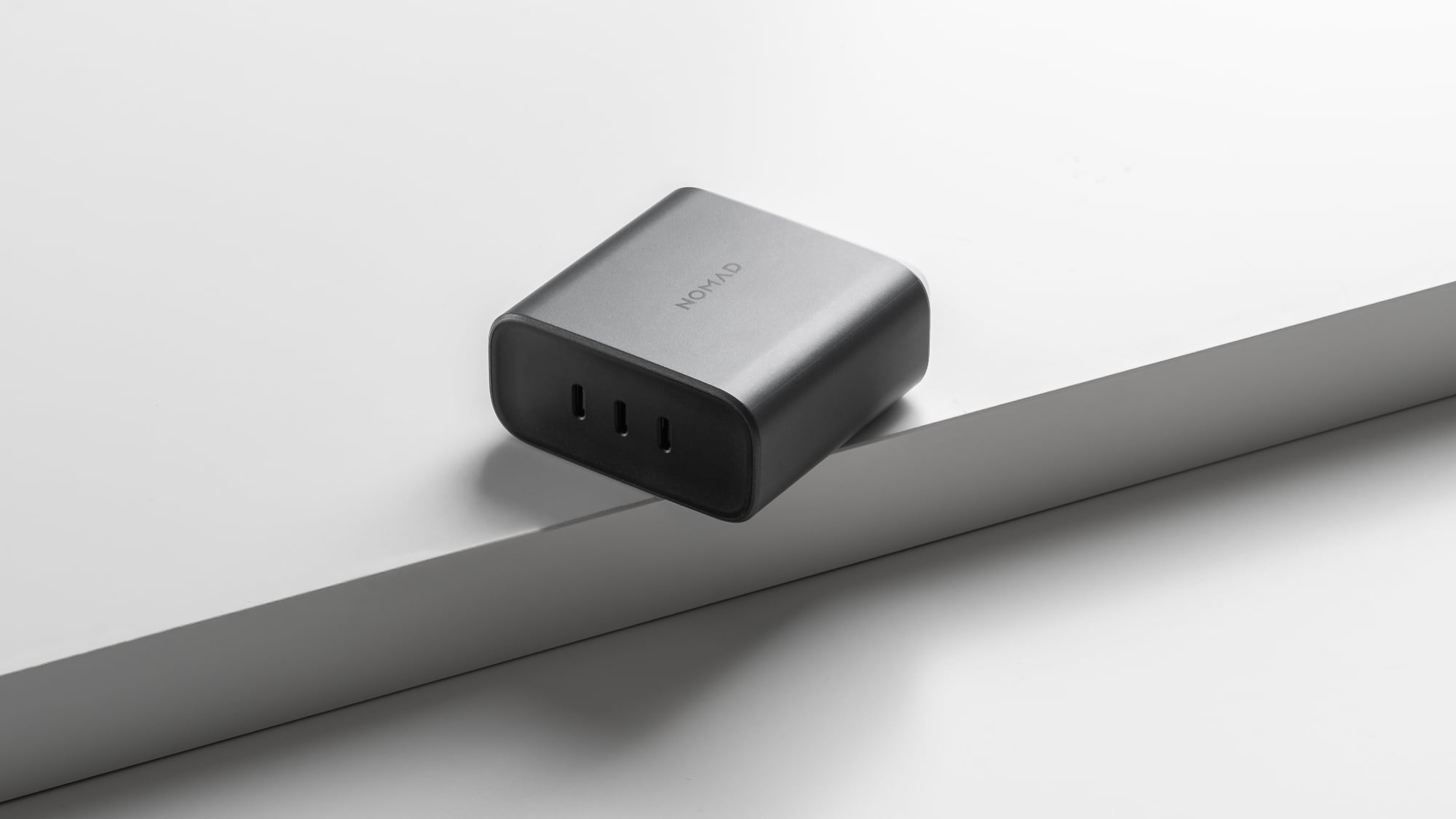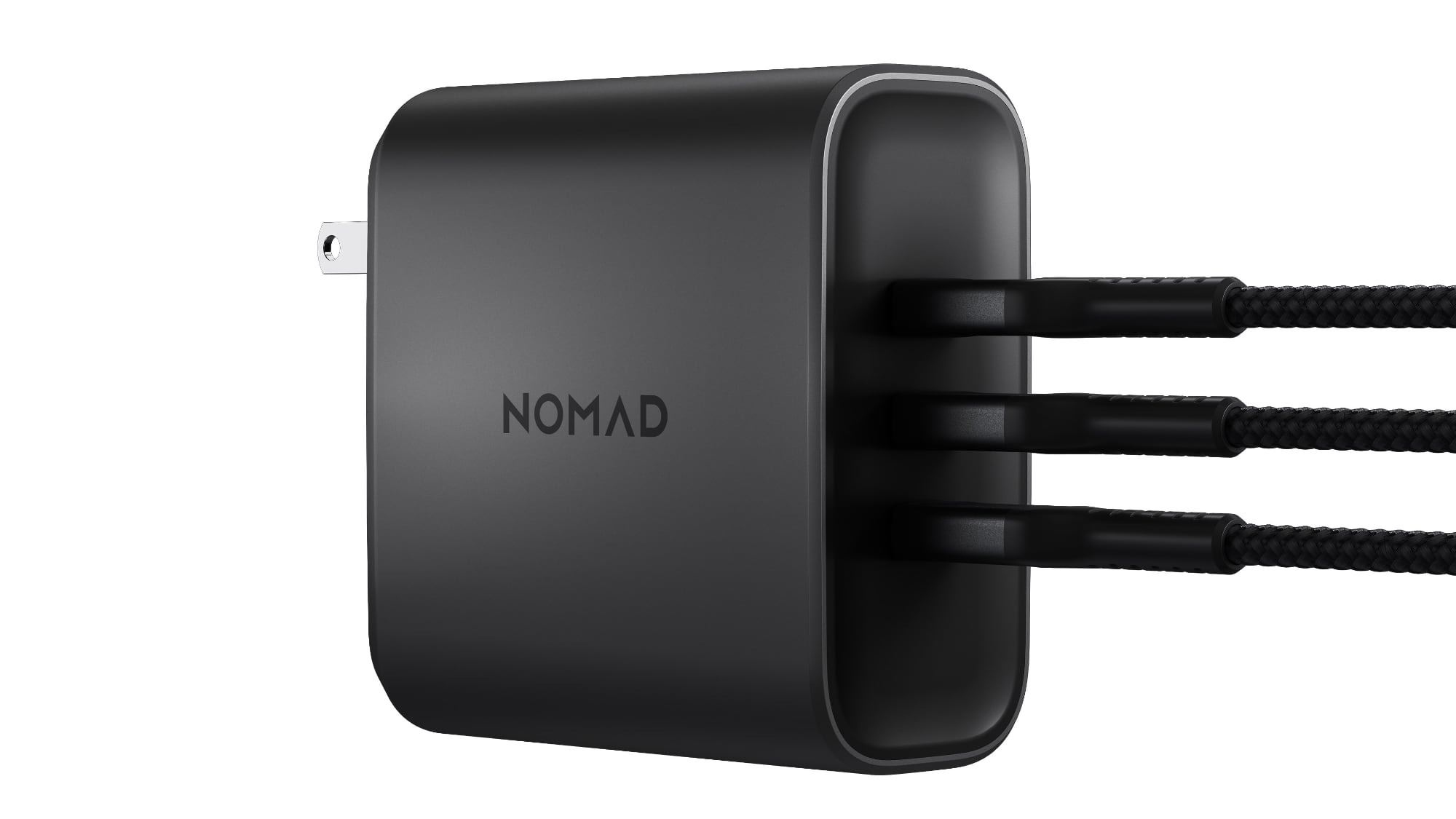My daily go to charger also has 3 USB-C and 1 USB-A. The USB-A port is handy to charge devices like razors and old power banks. It'll be a few years until I want the port gone from adapters- what harm is it doing when you have 3 USB C ports as well? None.Compared to this charger... it's a bonus. You still get 3 USB-C... just ignore the A if you don't need it.
Personally, I carry a USB-A to USB-C cable with me so that I can charge my lower power USB-C devices without taking up a USB-C port. For instance, my Sony headphones and Switch controllers both charge using USB-C, but don't need much juice so using that USB-A port for them is very handy so that I can leave the USB-C ports open for things that need more juice.
Got a tip for us?
Let us know
Become a MacRumors Supporter for $50/year with no ads, ability to filter front page stories, and private forums.
Review: Nomad's New 130W Power Adapter is Perfect for Multi-Device Charging
- Thread starter MacRumors
- Start date
- Sort by reaction score
You are using an out of date browser. It may not display this or other websites correctly.
You should upgrade or use an alternative browser.
You should upgrade or use an alternative browser.
I tape over any power indicator lights. Pretty easy to tell when a device is charging without needing an irritating light in the room when you want to sleep.But … wow, I miss the power indicator light. Anker’s latest is missing it also. It’s super handy when you can’t tell if that airport outlet, hotel outlet or random actually has power. It was a great visual on Anker’s early adapters.
This isn't a review of the product, just its specs. Test it, tear it apart, analyse it, or don't call it a review.
Nomad today introduced its most powerful charger to date, the 130W USB-C Power Adapter that's equipped with three USB-C PD ports. The 130W adapter joins Nomad's existing 65W, 30W, and 20W adapters.

Priced at $110, the 130W Power Adapter features the same design as Nomad's prior adapters, so if you have one of the smaller varieties, you can have a matching set. It's got a sleek black "carbide" enclosure, and it does use GaN (gallium nitride) technology to ensure a compact size.
I always find myself wishing Nomad made its accessories in white or other colors, but black is the Nomad aesthetic and it works. I can say without hesitation that this is the snazziest charging brick I've used, though I have to admit I don't often think too much about the build quality of the power adapter I'm using since it's out of sight and under the desk. If you have a charging setup on a desk or somewhere that looks matter, you won't be disappointed with the design of Nomad's Power Adapter.
Though the power adapter has three ports, it is smaller in size than the 140W charger from Apple that's designed for the 16-inch MacBook Pro models, and it is close in size to the Apple 96W power adapter. There are flip out prongs so when the charger is not in use, it folds down into a little cube that can be tucked away in a bag or a suitcase. I do want to point out that it has some heft - it's not a lightweight charger.

Each port is capable of 100W charging, but that is the maximum. You won't be able to get the 140W charging you're able to achieve on the 16-inch MacBook Pro with the MagSafe power adapter from Apple, but 100W is plenty for keeping power levels up while the MacBook Pro is in use. I rarely use the MagSafe port on my MacBook Pro for charging, and it's always at full battery when I'm at my desk regardless of what I'm doing. 100W is also enough power to max out all of Apple's other notebooks, and plenty for iPhones, iPads, and other USB-C accessories.
When charging multiple devices, Nomad's power adapter is able to intelligently split power. With two devices, it sends 100W to the top port and 30W to the other port, so you can charge a MacBook at full speed while also having 30W available for an iPhone or an iPad. With all three ports in use, the top port charges at 70W, while the two bottom ports get 30W each.
If you use just the bottom two ports and not the top port, you can get 65W with each port for evenly split power, and it's nice to have so many different charging options with one charger depending on which ports you opt for. With a minimum of 30W going to each port regardless of what's being charged, all three ports can fast charge an iPhone.
Bottom Line
Nomad's 130W Power Adapter is a convenient all-in-one power adapter thanks to its three ports and smart charging modes. It's useful for charging several devices at home, and equally helpful when traveling because you only need to pack a single power adapter.
At $110, the only downside is the price. That's a lot for a charger, but it is only $10 more than Apple's 140W charger, and it is not to far off of the price of similar chargers from companies like Anker and Satechi.
How to Buy
The Nomad 130W Power Adapter can be purchased from the Nomad website for $110.
Note: Nomad provided MacRumors with a 130W Power Adapter for the purpose of this review. No other compensation was received.
Article Link: Review: Nomad's New 130W Power Adapter is Perfect for Multi-Device Charging
Someone eventually made a 4 USB-C battery pack for those that have no more USB-A devices. I’ve no doubt that a 4 USB-C charger will come eventually.
NOMAD's site says nothing about it either.No mention of UL or other safety/regulatory agency rating?
That's a very important piece of information for many users who might be interested in purchasing one.
WARNING: Just visiting their site and I somehow got on their email list. Already got a Welcome email from them.
I live in CA and we have privacy laws with regards to what website can steal or track. Their site apparently doesn't care.
Last edited:
I get it, it’s good for old stuff. The thing is USB-C has been ruled to be the one cable to rule them all: worldwide (thanks EU!) So it’s time for current products to get with the program. There will always be adaptors, I plan on getting them for each of my Lightning ports when their cables fail. I’m not going to buy a new product with a USB-A port on it. For me it’s now obsolete. 🫶🏻I just thought it wasnt perfect becuase it has no A, plenty of things still use A. I have the anker one and it's the better option imo.
Someone really needs to sort out the utter mess of cables. They're all specced for different charging speeds and data speeds but half the time can't even live up to their unverified claims. This is when I would like Apple to step in with an MFI program of some sort to ensure we're not all using complete crap with our expensive devices. Even Anker make cables where they can't be bothered to write the power or data specs on the box!
I looked into this and discovered that it’s because, as a part of the standard, actually labeling cables is optional for members of the USB-IF (those not members of the USB-IF of course don’t care about labelingSomeone really needs to sort out the utter mess of cables. They're all specced for different charging speeds and data speeds but half the time can't even live up to their unverified claims. This is when I would like Apple to step in with an MFI program of some sort to ensure we're not all using complete crap with our expensive devices. Even Anker make cables where they can't be bothered to write the power or data specs on the box!
People wanting to save money on cables in the future may find themselves with more fried devices
Perhaps when cars & homes burn down, killing the occupants, the EU will require labeling… 😉I looked into this and discovered that it’s because, as a part of the standard, actually labeling cables is optional for members of the USB-IF (those not members of the USB-IF of course don’t care about labeling). This wasn’t SO bad with the older standards that only carried 12W, tops, as cheap cables can likely do as well as expensive ones at that low wattage. The introduction of USB-C has not made certain manufacturers improve their products, they STILL want to sell the cheapest cable that they can. Only now, some of these are expected to deliver up to 100W and MORE. What’s preventing a cable rated for 18W from being paired with a connector that will report to the charger that it should send 60W? Nothing.
People wanting to save money on cables in the future may find themselves with more fried devices
That's ridiculous that they don't require labelling. Though I suppose even if they did require it, who is actually checking that this stuff lives up to its claims?I looked into this and discovered that it’s because, as a part of the standard, actually labeling cables is optional for members of the USB-IF (those not members of the USB-IF of course don’t care about labeling). This wasn’t SO bad with the older standards that only carried 12W, tops, as cheap cables can likely do as well as expensive ones at that low wattage. The introduction of USB-C has not made certain manufacturers improve their products, they STILL want to sell the cheapest cable that they can. Only now, some of these are expected to deliver up to 100W and MORE. What’s preventing a cable rated for 18W from being paired with a connector that will report to the charger that it should send 60W? Nothing.
People wanting to save money on cables in the future may find themselves with more fried devices
For labeling to mean anything the cables would have to be tested before being labeled, each step adding to the cost of the cable. Chinese companies don’t care if your house burns down because you found their cheap cable on Amazon.That's ridiculous that they don't require labelling. Though I suppose even if they did require it, who is actually checking that this stuff lives up to its claims?
That's why the EU and UK have laws on electronics that foreign companies must obey....For labeling to mean anything the cables would have to be tested before being labeled, each step adding to the cost of the cable. Chinese companies don’t care if your house burns down because you found their cheap cable on Amazon.
So do the EU & the UK have laws to require testing & labeling of all USB-C cables, for their speed & wattage?That's why the EU and UK have laws on electronics that foreign companies must obey....
Here is a 2024 update for this thread. It seems like the Nomad 130 and Anker 150 Prime are still both great options in March 2024. I went with the Nomad because the Anker is an ugly piece of hardware! The gray plastic front reminds me of an old HP Pavilion desktop. 🤣
Register on MacRumors! This sidebar will go away, and you'll see fewer ads.


